Education and Training Report: Mentoring, Coaching, and Strategies
VerifiedAdded on 2022/09/09
|17
|5313
|34
Report
AI Summary
This report examines the concepts of education and training, focusing on mentoring, coaching, and teaching methodologies. It begins by defining and differentiating between teaching, coaching, and mentoring, highlighting their similarities and differences. The report then delves into a specific mentorship scenario, outlining the strategies and resources employed to support a learner, including building a relationship, active listening, setting realistic goals, and maintaining an optimistic approach. It identifies the mentor's roles and responsibilities, evaluates the effectiveness of the mentoring role, and discusses factors influencing the referral process, as well as collaboration with multi-agencies to support the learner. Finally, the report reflects on the mentor's strengths and areas for improvement, providing an action plan for future mentoring projects. The report covers topics such as the responsibilities of a mentor, teaching, coaching, and mentoring differences, and the effectiveness of mentorship.
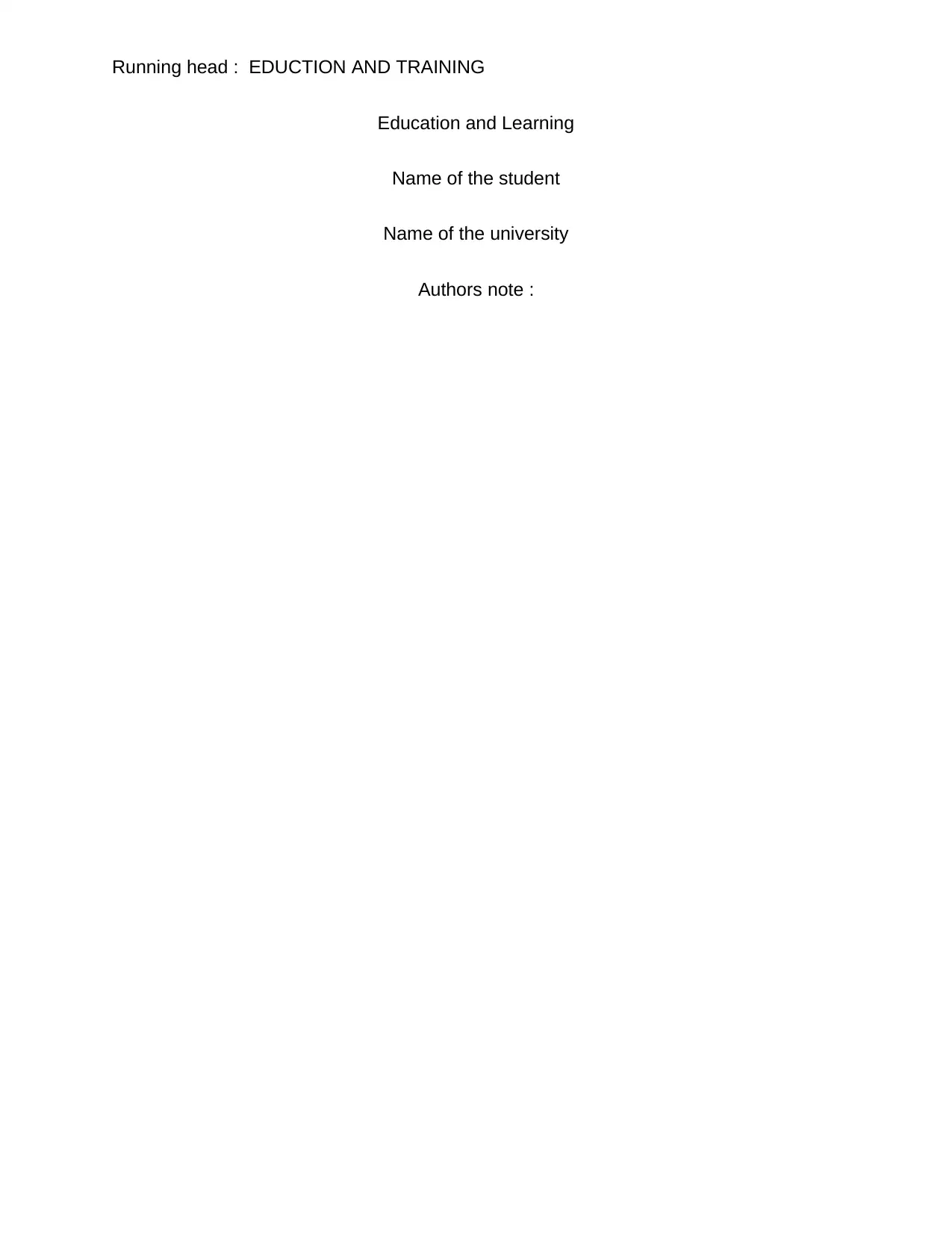
Running head : EDUCTION AND TRAINING
Education and Learning
Name of the student
Name of the university
Authors note :
Education and Learning
Name of the student
Name of the university
Authors note :
Paraphrase This Document
Need a fresh take? Get an instant paraphrase of this document with our AI Paraphraser

1EDUCATION AND TRAINING
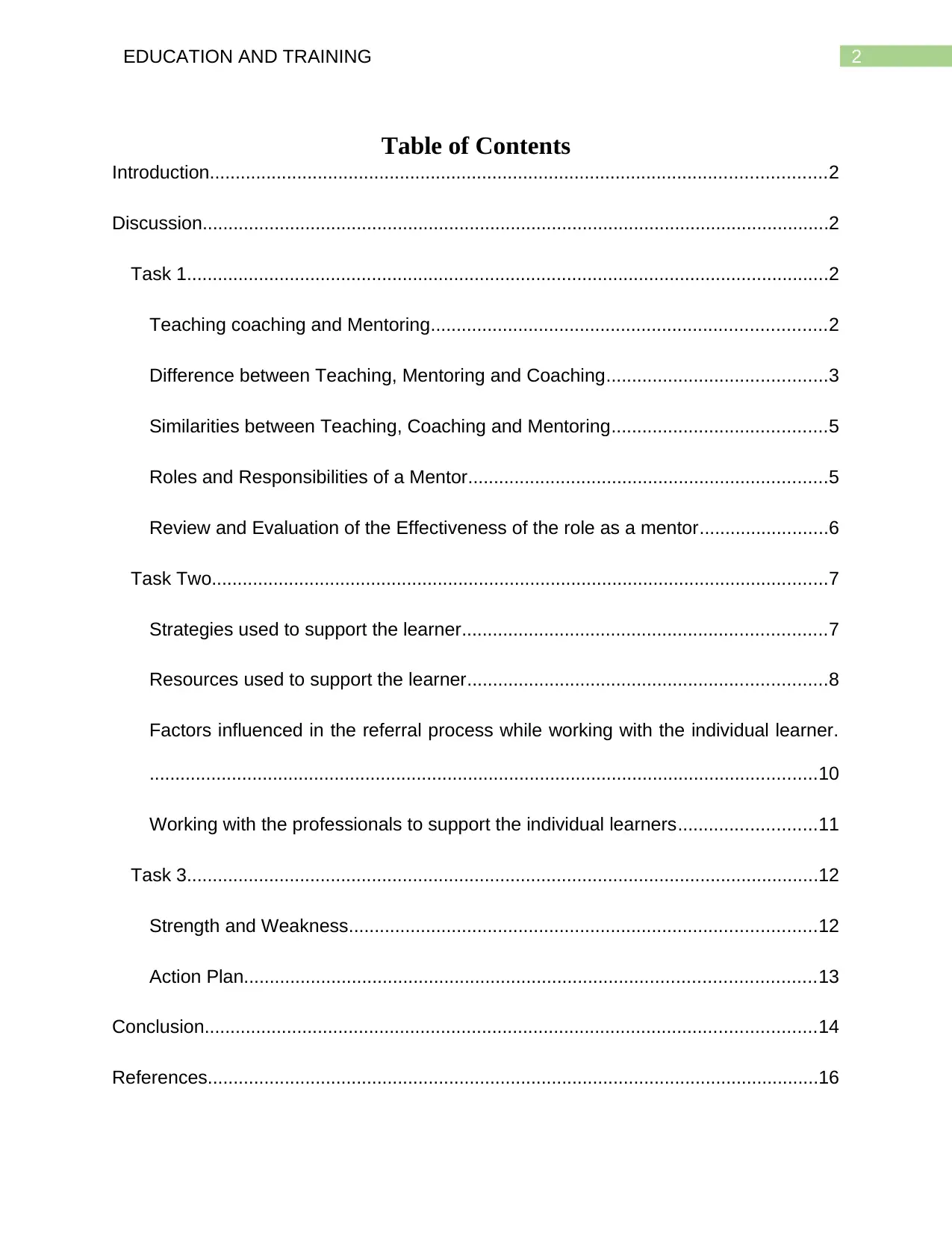
2EDUCATION AND TRAINING
Table of Contents
Introduction........................................................................................................................2
Discussion..........................................................................................................................2
Task 1.............................................................................................................................2
Teaching coaching and Mentoring.............................................................................2
Difference between Teaching, Mentoring and Coaching...........................................3
Similarities between Teaching, Coaching and Mentoring..........................................5
Roles and Responsibilities of a Mentor......................................................................5
Review and Evaluation of the Effectiveness of the role as a mentor.........................6
Task Two........................................................................................................................7
Strategies used to support the learner.......................................................................7
Resources used to support the learner......................................................................8
Factors influenced in the referral process while working with the individual learner.
..................................................................................................................................10
Working with the professionals to support the individual learners...........................11
Task 3...........................................................................................................................12
Strength and Weakness...........................................................................................12
Action Plan...............................................................................................................13
Conclusion.......................................................................................................................14
References.......................................................................................................................16
Table of Contents
Introduction........................................................................................................................2
Discussion..........................................................................................................................2
Task 1.............................................................................................................................2
Teaching coaching and Mentoring.............................................................................2
Difference between Teaching, Mentoring and Coaching...........................................3
Similarities between Teaching, Coaching and Mentoring..........................................5
Roles and Responsibilities of a Mentor......................................................................5
Review and Evaluation of the Effectiveness of the role as a mentor.........................6
Task Two........................................................................................................................7
Strategies used to support the learner.......................................................................7
Resources used to support the learner......................................................................8
Factors influenced in the referral process while working with the individual learner.
..................................................................................................................................10
Working with the professionals to support the individual learners...........................11
Task 3...........................................................................................................................12
Strength and Weakness...........................................................................................12
Action Plan...............................................................................................................13
Conclusion.......................................................................................................................14
References.......................................................................................................................16
⊘ This is a preview!⊘
Do you want full access?
Subscribe today to unlock all pages.

Trusted by 1+ million students worldwide
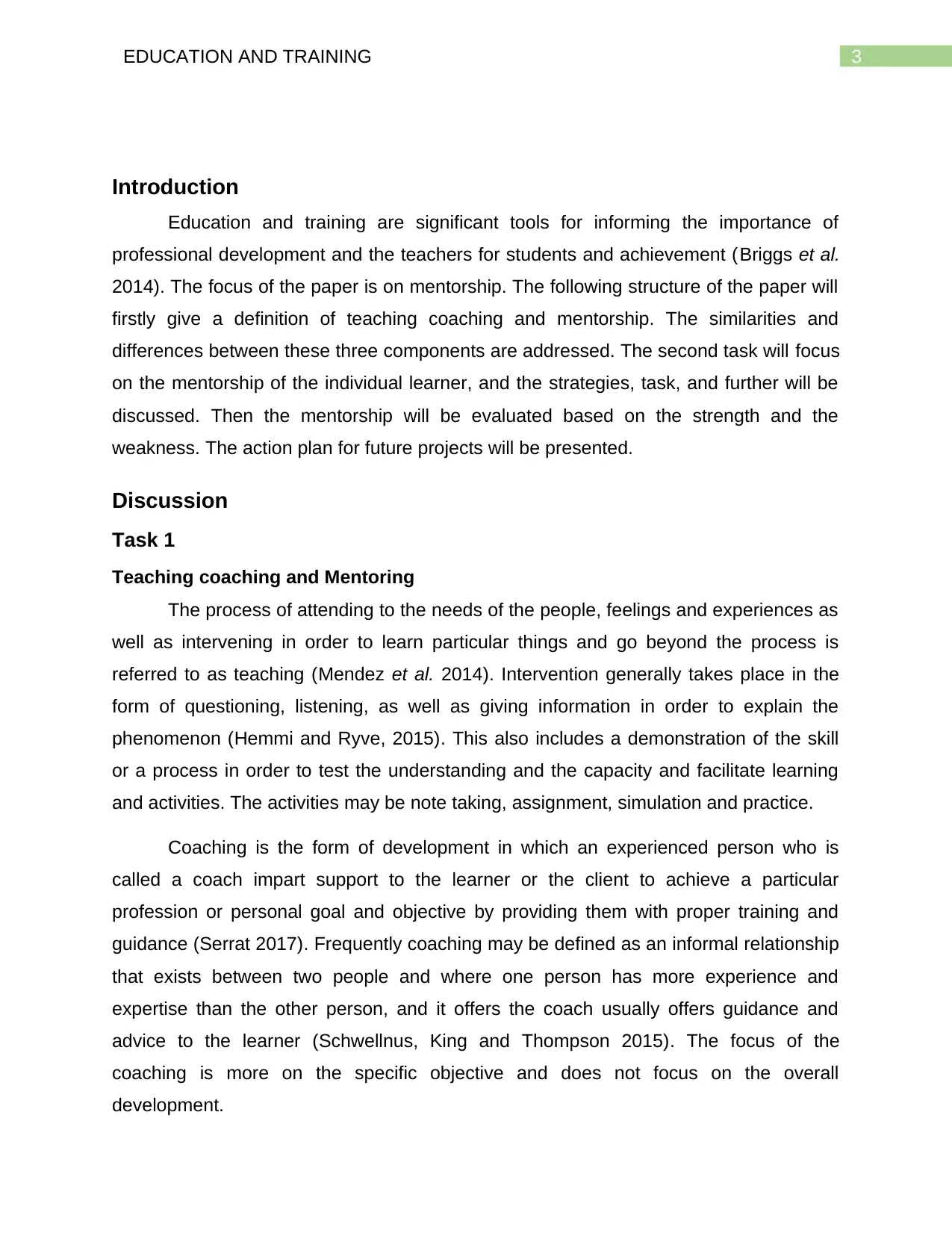
3EDUCATION AND TRAINING
Introduction
Education and training are significant tools for informing the importance of
professional development and the teachers for students and achievement (Briggs et al.
2014). The focus of the paper is on mentorship. The following structure of the paper will
firstly give a definition of teaching coaching and mentorship. The similarities and
differences between these three components are addressed. The second task will focus
on the mentorship of the individual learner, and the strategies, task, and further will be
discussed. Then the mentorship will be evaluated based on the strength and the
weakness. The action plan for future projects will be presented.
Discussion
Task 1
Teaching coaching and Mentoring
The process of attending to the needs of the people, feelings and experiences as
well as intervening in order to learn particular things and go beyond the process is
referred to as teaching (Mendez et al. 2014). Intervention generally takes place in the
form of questioning, listening, as well as giving information in order to explain the
phenomenon (Hemmi and Ryve, 2015). This also includes a demonstration of the skill
or a process in order to test the understanding and the capacity and facilitate learning
and activities. The activities may be note taking, assignment, simulation and practice.
Coaching is the form of development in which an experienced person who is
called a coach impart support to the learner or the client to achieve a particular
profession or personal goal and objective by providing them with proper training and
guidance (Serrat 2017). Frequently coaching may be defined as an informal relationship
that exists between two people and where one person has more experience and
expertise than the other person, and it offers the coach usually offers guidance and
advice to the learner (Schwellnus, King and Thompson 2015). The focus of the
coaching is more on the specific objective and does not focus on the overall
development.
Introduction
Education and training are significant tools for informing the importance of
professional development and the teachers for students and achievement (Briggs et al.
2014). The focus of the paper is on mentorship. The following structure of the paper will
firstly give a definition of teaching coaching and mentorship. The similarities and
differences between these three components are addressed. The second task will focus
on the mentorship of the individual learner, and the strategies, task, and further will be
discussed. Then the mentorship will be evaluated based on the strength and the
weakness. The action plan for future projects will be presented.
Discussion
Task 1
Teaching coaching and Mentoring
The process of attending to the needs of the people, feelings and experiences as
well as intervening in order to learn particular things and go beyond the process is
referred to as teaching (Mendez et al. 2014). Intervention generally takes place in the
form of questioning, listening, as well as giving information in order to explain the
phenomenon (Hemmi and Ryve, 2015). This also includes a demonstration of the skill
or a process in order to test the understanding and the capacity and facilitate learning
and activities. The activities may be note taking, assignment, simulation and practice.
Coaching is the form of development in which an experienced person who is
called a coach impart support to the learner or the client to achieve a particular
profession or personal goal and objective by providing them with proper training and
guidance (Serrat 2017). Frequently coaching may be defined as an informal relationship
that exists between two people and where one person has more experience and
expertise than the other person, and it offers the coach usually offers guidance and
advice to the learner (Schwellnus, King and Thompson 2015). The focus of the
coaching is more on the specific objective and does not focus on the overall
development.
Paraphrase This Document
Need a fresh take? Get an instant paraphrase of this document with our AI Paraphraser
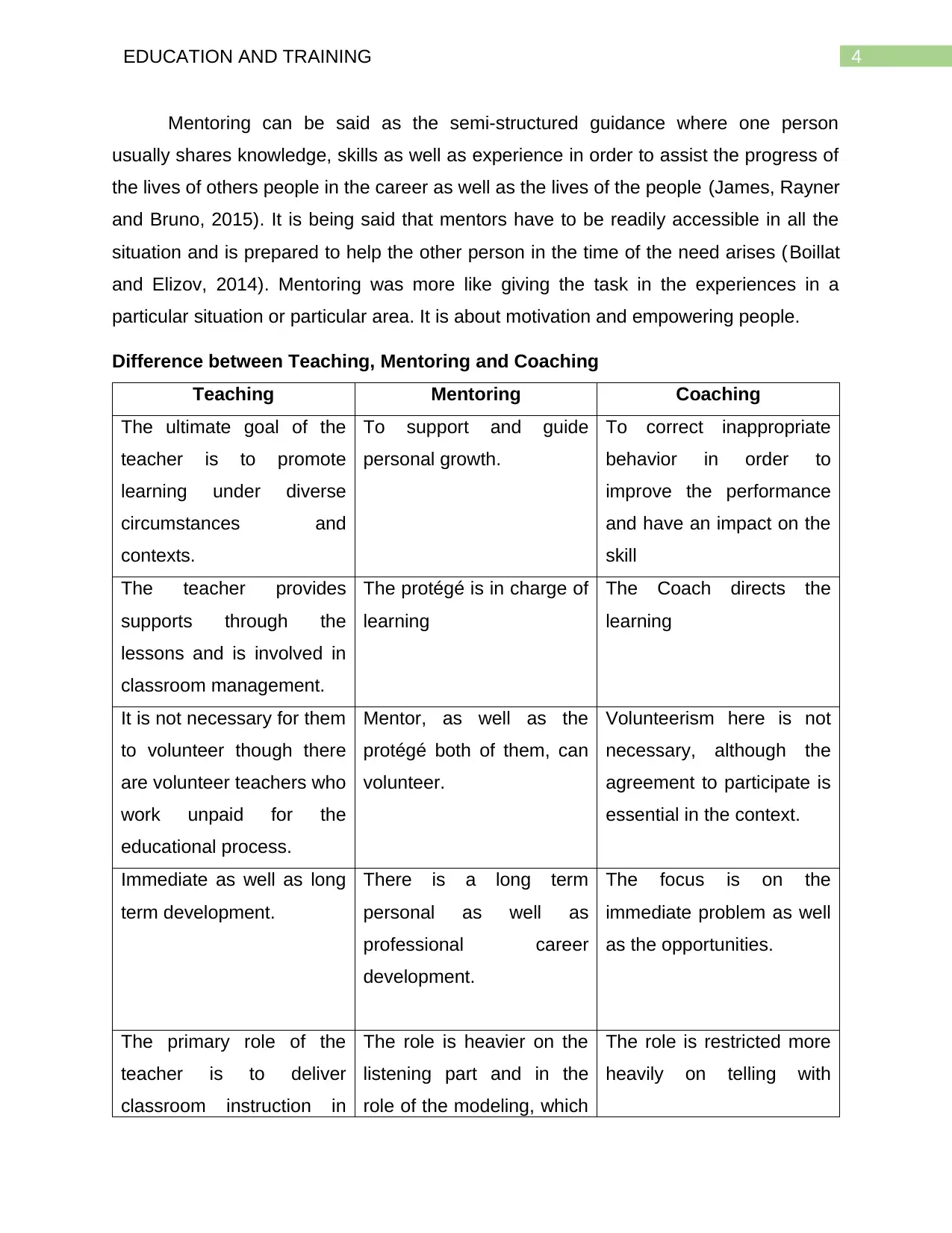
4EDUCATION AND TRAINING
Mentoring can be said as the semi-structured guidance where one person
usually shares knowledge, skills as well as experience in order to assist the progress of
the lives of others people in the career as well as the lives of the people (James, Rayner
and Bruno, 2015). It is being said that mentors have to be readily accessible in all the
situation and is prepared to help the other person in the time of the need arises (Boillat
and Elizov, 2014). Mentoring was more like giving the task in the experiences in a
particular situation or particular area. It is about motivation and empowering people.
Difference between Teaching, Mentoring and Coaching
Teaching Mentoring Coaching
The ultimate goal of the
teacher is to promote
learning under diverse
circumstances and
contexts.
To support and guide
personal growth.
To correct inappropriate
behavior in order to
improve the performance
and have an impact on the
skill
The teacher provides
supports through the
lessons and is involved in
classroom management.
The protégé is in charge of
learning
The Coach directs the
learning
It is not necessary for them
to volunteer though there
are volunteer teachers who
work unpaid for the
educational process.
Mentor, as well as the
protégé both of them, can
volunteer.
Volunteerism here is not
necessary, although the
agreement to participate is
essential in the context.
Immediate as well as long
term development.
There is a long term
personal as well as
professional career
development.
The focus is on the
immediate problem as well
as the opportunities.
The primary role of the
teacher is to deliver
classroom instruction in
The role is heavier on the
listening part and in the
role of the modeling, which
The role is restricted more
heavily on telling with
Mentoring can be said as the semi-structured guidance where one person
usually shares knowledge, skills as well as experience in order to assist the progress of
the lives of others people in the career as well as the lives of the people (James, Rayner
and Bruno, 2015). It is being said that mentors have to be readily accessible in all the
situation and is prepared to help the other person in the time of the need arises (Boillat
and Elizov, 2014). Mentoring was more like giving the task in the experiences in a
particular situation or particular area. It is about motivation and empowering people.
Difference between Teaching, Mentoring and Coaching
Teaching Mentoring Coaching
The ultimate goal of the
teacher is to promote
learning under diverse
circumstances and
contexts.
To support and guide
personal growth.
To correct inappropriate
behavior in order to
improve the performance
and have an impact on the
skill
The teacher provides
supports through the
lessons and is involved in
classroom management.
The protégé is in charge of
learning
The Coach directs the
learning
It is not necessary for them
to volunteer though there
are volunteer teachers who
work unpaid for the
educational process.
Mentor, as well as the
protégé both of them, can
volunteer.
Volunteerism here is not
necessary, although the
agreement to participate is
essential in the context.
Immediate as well as long
term development.
There is a long term
personal as well as
professional career
development.
The focus is on the
immediate problem as well
as the opportunities.
The primary role of the
teacher is to deliver
classroom instruction in
The role is heavier on the
listening part and in the
role of the modeling, which
The role is restricted more
heavily on telling with
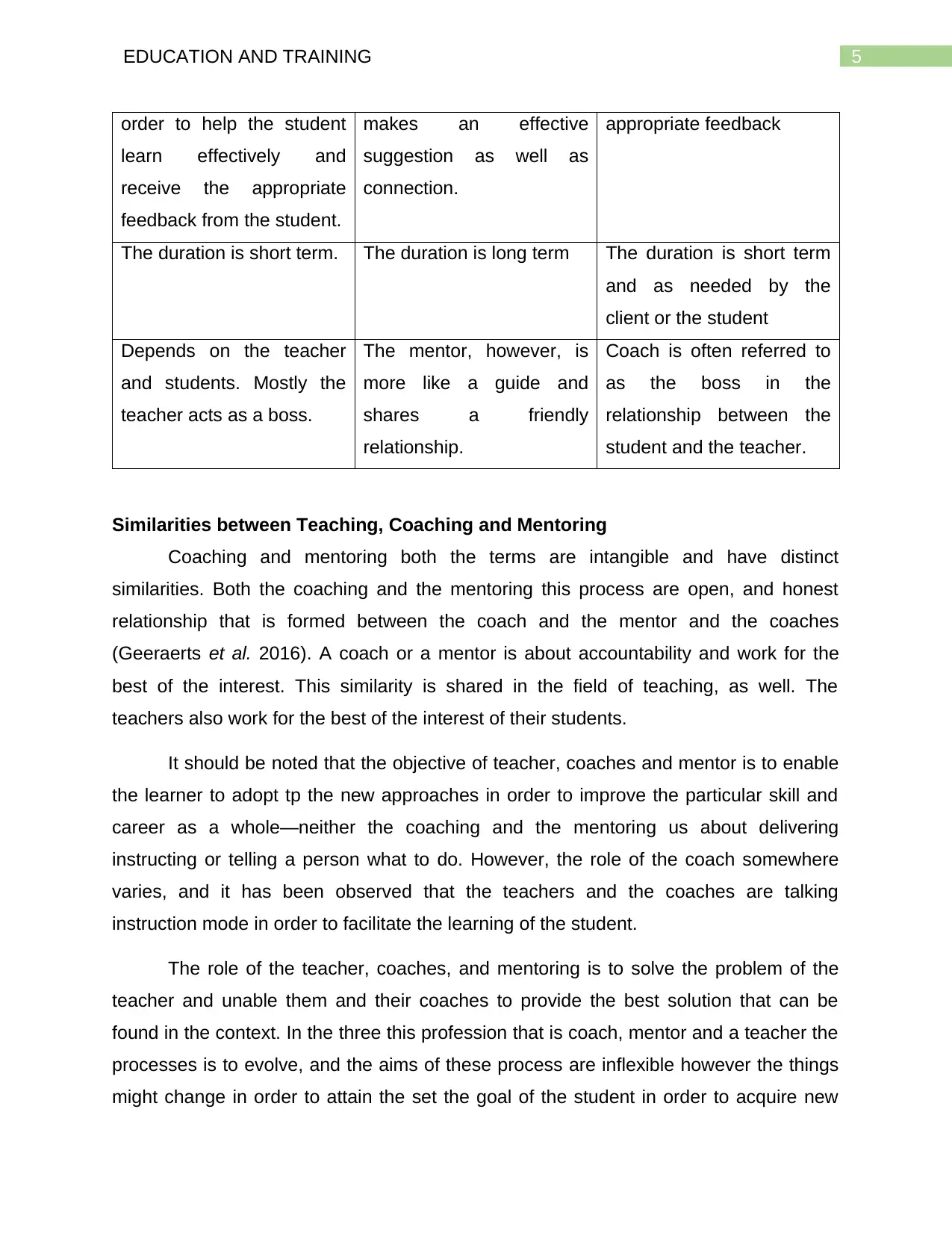
5EDUCATION AND TRAINING
order to help the student
learn effectively and
receive the appropriate
feedback from the student.
makes an effective
suggestion as well as
connection.
appropriate feedback
The duration is short term. The duration is long term The duration is short term
and as needed by the
client or the student
Depends on the teacher
and students. Mostly the
teacher acts as a boss.
The mentor, however, is
more like a guide and
shares a friendly
relationship.
Coach is often referred to
as the boss in the
relationship between the
student and the teacher.
Similarities between Teaching, Coaching and Mentoring
Coaching and mentoring both the terms are intangible and have distinct
similarities. Both the coaching and the mentoring this process are open, and honest
relationship that is formed between the coach and the mentor and the coaches
(Geeraerts et al. 2016). A coach or a mentor is about accountability and work for the
best of the interest. This similarity is shared in the field of teaching, as well. The
teachers also work for the best of the interest of their students.
It should be noted that the objective of teacher, coaches and mentor is to enable
the learner to adopt tp the new approaches in order to improve the particular skill and
career as a whole—neither the coaching and the mentoring us about delivering
instructing or telling a person what to do. However, the role of the coach somewhere
varies, and it has been observed that the teachers and the coaches are talking
instruction mode in order to facilitate the learning of the student.
The role of the teacher, coaches, and mentoring is to solve the problem of the
teacher and unable them and their coaches to provide the best solution that can be
found in the context. In the three this profession that is coach, mentor and a teacher the
processes is to evolve, and the aims of these process are inflexible however the things
might change in order to attain the set the goal of the student in order to acquire new
order to help the student
learn effectively and
receive the appropriate
feedback from the student.
makes an effective
suggestion as well as
connection.
appropriate feedback
The duration is short term. The duration is long term The duration is short term
and as needed by the
client or the student
Depends on the teacher
and students. Mostly the
teacher acts as a boss.
The mentor, however, is
more like a guide and
shares a friendly
relationship.
Coach is often referred to
as the boss in the
relationship between the
student and the teacher.
Similarities between Teaching, Coaching and Mentoring
Coaching and mentoring both the terms are intangible and have distinct
similarities. Both the coaching and the mentoring this process are open, and honest
relationship that is formed between the coach and the mentor and the coaches
(Geeraerts et al. 2016). A coach or a mentor is about accountability and work for the
best of the interest. This similarity is shared in the field of teaching, as well. The
teachers also work for the best of the interest of their students.
It should be noted that the objective of teacher, coaches and mentor is to enable
the learner to adopt tp the new approaches in order to improve the particular skill and
career as a whole—neither the coaching and the mentoring us about delivering
instructing or telling a person what to do. However, the role of the coach somewhere
varies, and it has been observed that the teachers and the coaches are talking
instruction mode in order to facilitate the learning of the student.
The role of the teacher, coaches, and mentoring is to solve the problem of the
teacher and unable them and their coaches to provide the best solution that can be
found in the context. In the three this profession that is coach, mentor and a teacher the
processes is to evolve, and the aims of these process are inflexible however the things
might change in order to attain the set the goal of the student in order to acquire new
⊘ This is a preview!⊘
Do you want full access?
Subscribe today to unlock all pages.

Trusted by 1+ million students worldwide
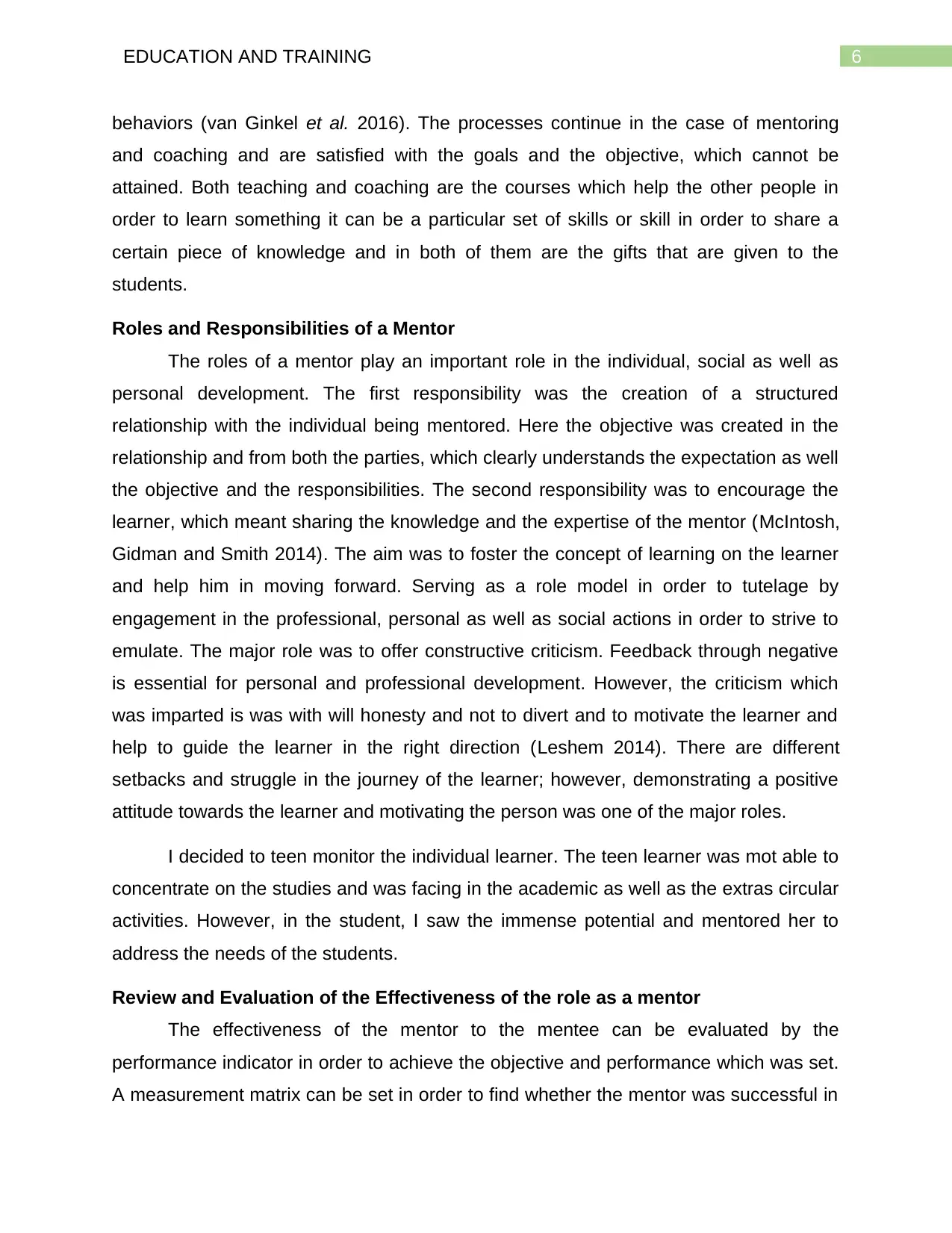
6EDUCATION AND TRAINING
behaviors (van Ginkel et al. 2016). The processes continue in the case of mentoring
and coaching and are satisfied with the goals and the objective, which cannot be
attained. Both teaching and coaching are the courses which help the other people in
order to learn something it can be a particular set of skills or skill in order to share a
certain piece of knowledge and in both of them are the gifts that are given to the
students.
Roles and Responsibilities of a Mentor
The roles of a mentor play an important role in the individual, social as well as
personal development. The first responsibility was the creation of a structured
relationship with the individual being mentored. Here the objective was created in the
relationship and from both the parties, which clearly understands the expectation as well
the objective and the responsibilities. The second responsibility was to encourage the
learner, which meant sharing the knowledge and the expertise of the mentor (McIntosh,
Gidman and Smith 2014). The aim was to foster the concept of learning on the learner
and help him in moving forward. Serving as a role model in order to tutelage by
engagement in the professional, personal as well as social actions in order to strive to
emulate. The major role was to offer constructive criticism. Feedback through negative
is essential for personal and professional development. However, the criticism which
was imparted is was with will honesty and not to divert and to motivate the learner and
help to guide the learner in the right direction (Leshem 2014). There are different
setbacks and struggle in the journey of the learner; however, demonstrating a positive
attitude towards the learner and motivating the person was one of the major roles.
I decided to teen monitor the individual learner. The teen learner was mot able to
concentrate on the studies and was facing in the academic as well as the extras circular
activities. However, in the student, I saw the immense potential and mentored her to
address the needs of the students.
Review and Evaluation of the Effectiveness of the role as a mentor
The effectiveness of the mentor to the mentee can be evaluated by the
performance indicator in order to achieve the objective and performance which was set.
A measurement matrix can be set in order to find whether the mentor was successful in
behaviors (van Ginkel et al. 2016). The processes continue in the case of mentoring
and coaching and are satisfied with the goals and the objective, which cannot be
attained. Both teaching and coaching are the courses which help the other people in
order to learn something it can be a particular set of skills or skill in order to share a
certain piece of knowledge and in both of them are the gifts that are given to the
students.
Roles and Responsibilities of a Mentor
The roles of a mentor play an important role in the individual, social as well as
personal development. The first responsibility was the creation of a structured
relationship with the individual being mentored. Here the objective was created in the
relationship and from both the parties, which clearly understands the expectation as well
the objective and the responsibilities. The second responsibility was to encourage the
learner, which meant sharing the knowledge and the expertise of the mentor (McIntosh,
Gidman and Smith 2014). The aim was to foster the concept of learning on the learner
and help him in moving forward. Serving as a role model in order to tutelage by
engagement in the professional, personal as well as social actions in order to strive to
emulate. The major role was to offer constructive criticism. Feedback through negative
is essential for personal and professional development. However, the criticism which
was imparted is was with will honesty and not to divert and to motivate the learner and
help to guide the learner in the right direction (Leshem 2014). There are different
setbacks and struggle in the journey of the learner; however, demonstrating a positive
attitude towards the learner and motivating the person was one of the major roles.
I decided to teen monitor the individual learner. The teen learner was mot able to
concentrate on the studies and was facing in the academic as well as the extras circular
activities. However, in the student, I saw the immense potential and mentored her to
address the needs of the students.
Review and Evaluation of the Effectiveness of the role as a mentor
The effectiveness of the mentor to the mentee can be evaluated by the
performance indicator in order to achieve the objective and performance which was set.
A measurement matrix can be set in order to find whether the mentor was successful in
Paraphrase This Document
Need a fresh take? Get an instant paraphrase of this document with our AI Paraphraser
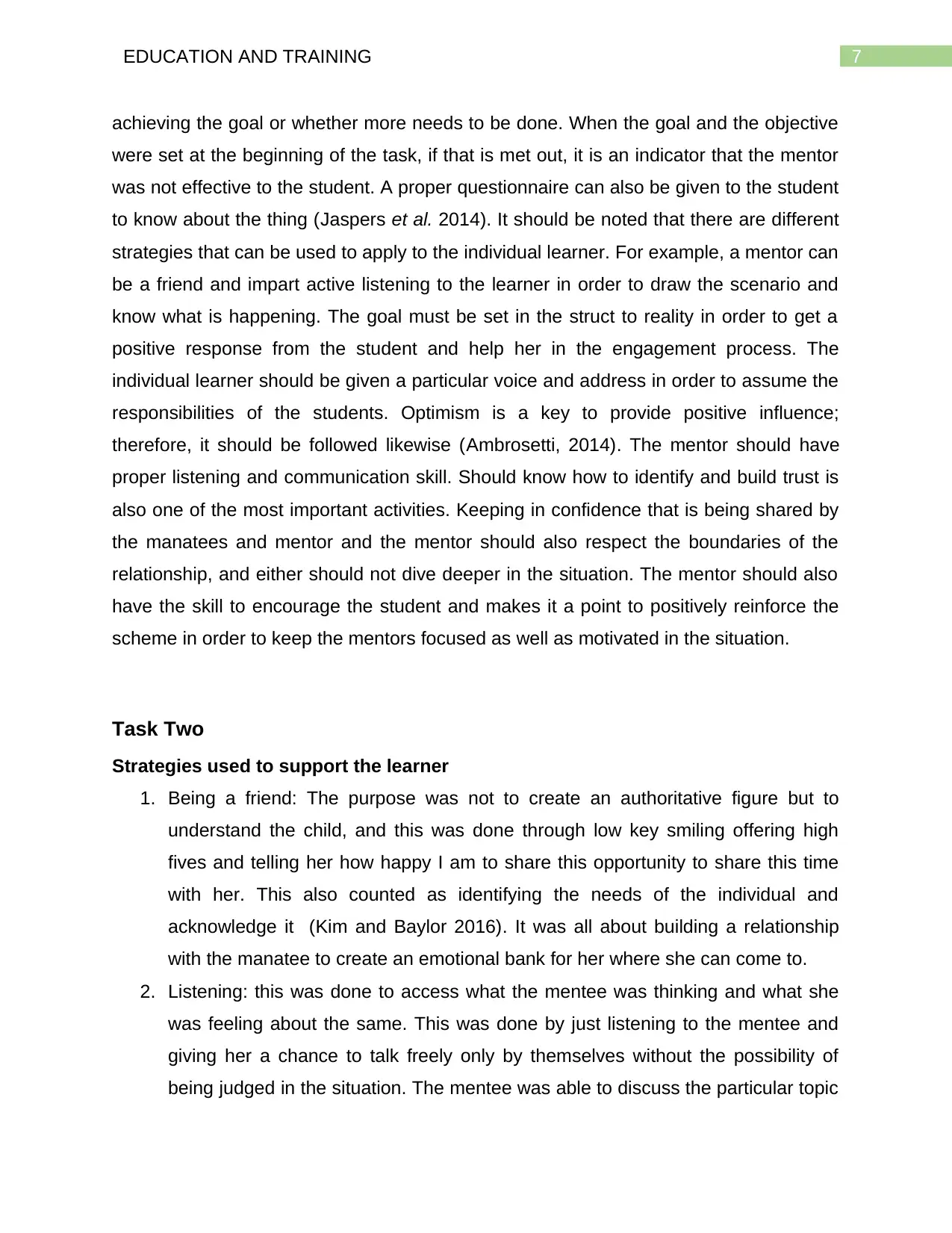
7EDUCATION AND TRAINING
achieving the goal or whether more needs to be done. When the goal and the objective
were set at the beginning of the task, if that is met out, it is an indicator that the mentor
was not effective to the student. A proper questionnaire can also be given to the student
to know about the thing (Jaspers et al. 2014). It should be noted that there are different
strategies that can be used to apply to the individual learner. For example, a mentor can
be a friend and impart active listening to the learner in order to draw the scenario and
know what is happening. The goal must be set in the struct to reality in order to get a
positive response from the student and help her in the engagement process. The
individual learner should be given a particular voice and address in order to assume the
responsibilities of the students. Optimism is a key to provide positive influence;
therefore, it should be followed likewise (Ambrosetti, 2014). The mentor should have
proper listening and communication skill. Should know how to identify and build trust is
also one of the most important activities. Keeping in confidence that is being shared by
the manatees and mentor and the mentor should also respect the boundaries of the
relationship, and either should not dive deeper in the situation. The mentor should also
have the skill to encourage the student and makes it a point to positively reinforce the
scheme in order to keep the mentors focused as well as motivated in the situation.
Task Two
Strategies used to support the learner
1. Being a friend: The purpose was not to create an authoritative figure but to
understand the child, and this was done through low key smiling offering high
fives and telling her how happy I am to share this opportunity to share this time
with her. This also counted as identifying the needs of the individual and
acknowledge it (Kim and Baylor 2016). It was all about building a relationship
with the manatee to create an emotional bank for her where she can come to.
2. Listening: this was done to access what the mentee was thinking and what she
was feeling about the same. This was done by just listening to the mentee and
giving her a chance to talk freely only by themselves without the possibility of
being judged in the situation. The mentee was able to discuss the particular topic
achieving the goal or whether more needs to be done. When the goal and the objective
were set at the beginning of the task, if that is met out, it is an indicator that the mentor
was not effective to the student. A proper questionnaire can also be given to the student
to know about the thing (Jaspers et al. 2014). It should be noted that there are different
strategies that can be used to apply to the individual learner. For example, a mentor can
be a friend and impart active listening to the learner in order to draw the scenario and
know what is happening. The goal must be set in the struct to reality in order to get a
positive response from the student and help her in the engagement process. The
individual learner should be given a particular voice and address in order to assume the
responsibilities of the students. Optimism is a key to provide positive influence;
therefore, it should be followed likewise (Ambrosetti, 2014). The mentor should have
proper listening and communication skill. Should know how to identify and build trust is
also one of the most important activities. Keeping in confidence that is being shared by
the manatees and mentor and the mentor should also respect the boundaries of the
relationship, and either should not dive deeper in the situation. The mentor should also
have the skill to encourage the student and makes it a point to positively reinforce the
scheme in order to keep the mentors focused as well as motivated in the situation.
Task Two
Strategies used to support the learner
1. Being a friend: The purpose was not to create an authoritative figure but to
understand the child, and this was done through low key smiling offering high
fives and telling her how happy I am to share this opportunity to share this time
with her. This also counted as identifying the needs of the individual and
acknowledge it (Kim and Baylor 2016). It was all about building a relationship
with the manatee to create an emotional bank for her where she can come to.
2. Listening: this was done to access what the mentee was thinking and what she
was feeling about the same. This was done by just listening to the mentee and
giving her a chance to talk freely only by themselves without the possibility of
being judged in the situation. The mentee was able to discuss the particular topic
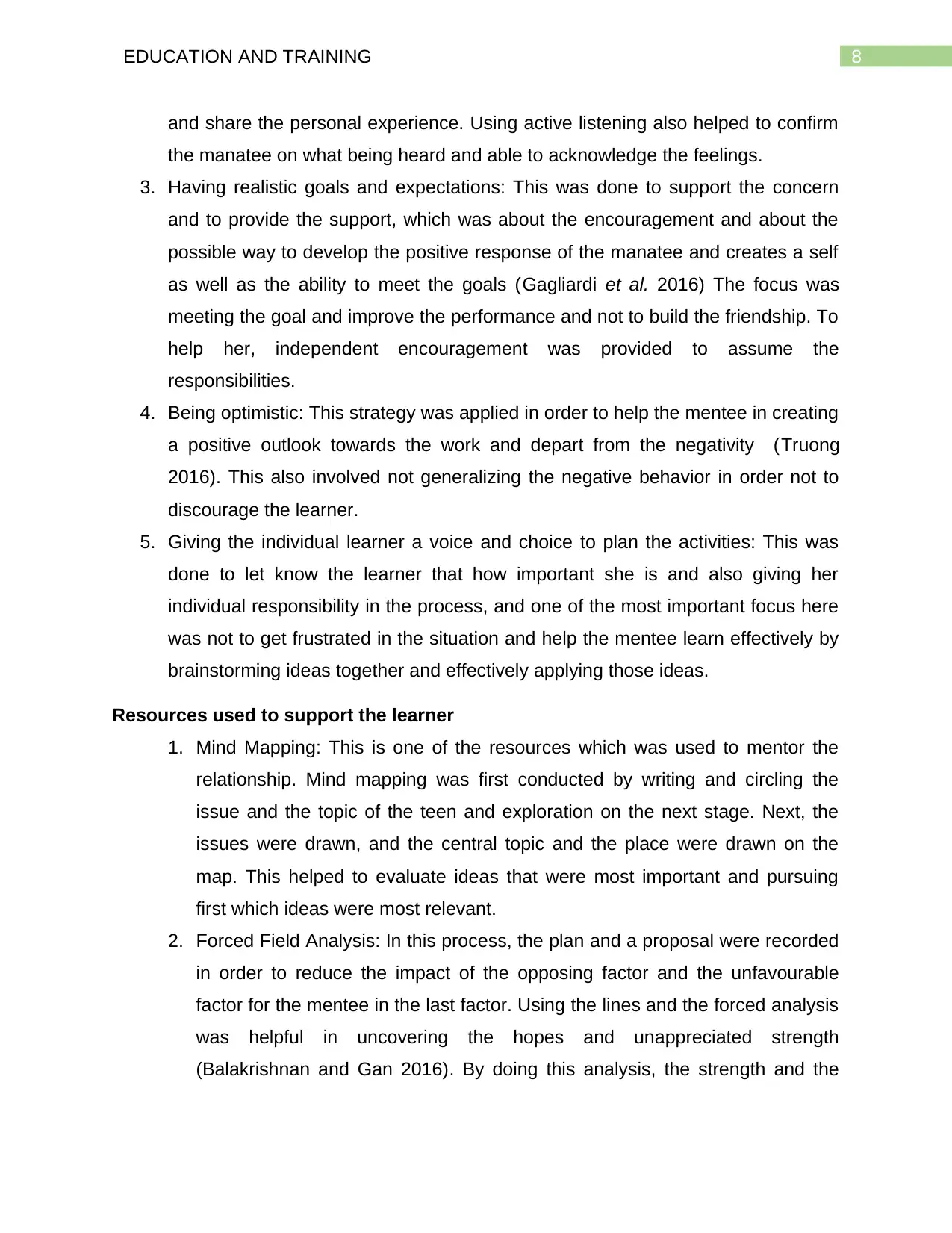
8EDUCATION AND TRAINING
and share the personal experience. Using active listening also helped to confirm
the manatee on what being heard and able to acknowledge the feelings.
3. Having realistic goals and expectations: This was done to support the concern
and to provide the support, which was about the encouragement and about the
possible way to develop the positive response of the manatee and creates a self
as well as the ability to meet the goals (Gagliardi et al. 2016) The focus was
meeting the goal and improve the performance and not to build the friendship. To
help her, independent encouragement was provided to assume the
responsibilities.
4. Being optimistic: This strategy was applied in order to help the mentee in creating
a positive outlook towards the work and depart from the negativity (Truong
2016). This also involved not generalizing the negative behavior in order not to
discourage the learner.
5. Giving the individual learner a voice and choice to plan the activities: This was
done to let know the learner that how important she is and also giving her
individual responsibility in the process, and one of the most important focus here
was not to get frustrated in the situation and help the mentee learn effectively by
brainstorming ideas together and effectively applying those ideas.
Resources used to support the learner
1. Mind Mapping: This is one of the resources which was used to mentor the
relationship. Mind mapping was first conducted by writing and circling the
issue and the topic of the teen and exploration on the next stage. Next, the
issues were drawn, and the central topic and the place were drawn on the
map. This helped to evaluate ideas that were most important and pursuing
first which ideas were most relevant.
2. Forced Field Analysis: In this process, the plan and a proposal were recorded
in order to reduce the impact of the opposing factor and the unfavourable
factor for the mentee in the last factor. Using the lines and the forced analysis
was helpful in uncovering the hopes and unappreciated strength
(Balakrishnan and Gan 2016). By doing this analysis, the strength and the
and share the personal experience. Using active listening also helped to confirm
the manatee on what being heard and able to acknowledge the feelings.
3. Having realistic goals and expectations: This was done to support the concern
and to provide the support, which was about the encouragement and about the
possible way to develop the positive response of the manatee and creates a self
as well as the ability to meet the goals (Gagliardi et al. 2016) The focus was
meeting the goal and improve the performance and not to build the friendship. To
help her, independent encouragement was provided to assume the
responsibilities.
4. Being optimistic: This strategy was applied in order to help the mentee in creating
a positive outlook towards the work and depart from the negativity (Truong
2016). This also involved not generalizing the negative behavior in order not to
discourage the learner.
5. Giving the individual learner a voice and choice to plan the activities: This was
done to let know the learner that how important she is and also giving her
individual responsibility in the process, and one of the most important focus here
was not to get frustrated in the situation and help the mentee learn effectively by
brainstorming ideas together and effectively applying those ideas.
Resources used to support the learner
1. Mind Mapping: This is one of the resources which was used to mentor the
relationship. Mind mapping was first conducted by writing and circling the
issue and the topic of the teen and exploration on the next stage. Next, the
issues were drawn, and the central topic and the place were drawn on the
map. This helped to evaluate ideas that were most important and pursuing
first which ideas were most relevant.
2. Forced Field Analysis: In this process, the plan and a proposal were recorded
in order to reduce the impact of the opposing factor and the unfavourable
factor for the mentee in the last factor. Using the lines and the forced analysis
was helpful in uncovering the hopes and unappreciated strength
(Balakrishnan and Gan 2016). By doing this analysis, the strength and the
⊘ This is a preview!⊘
Do you want full access?
Subscribe today to unlock all pages.

Trusted by 1+ million students worldwide
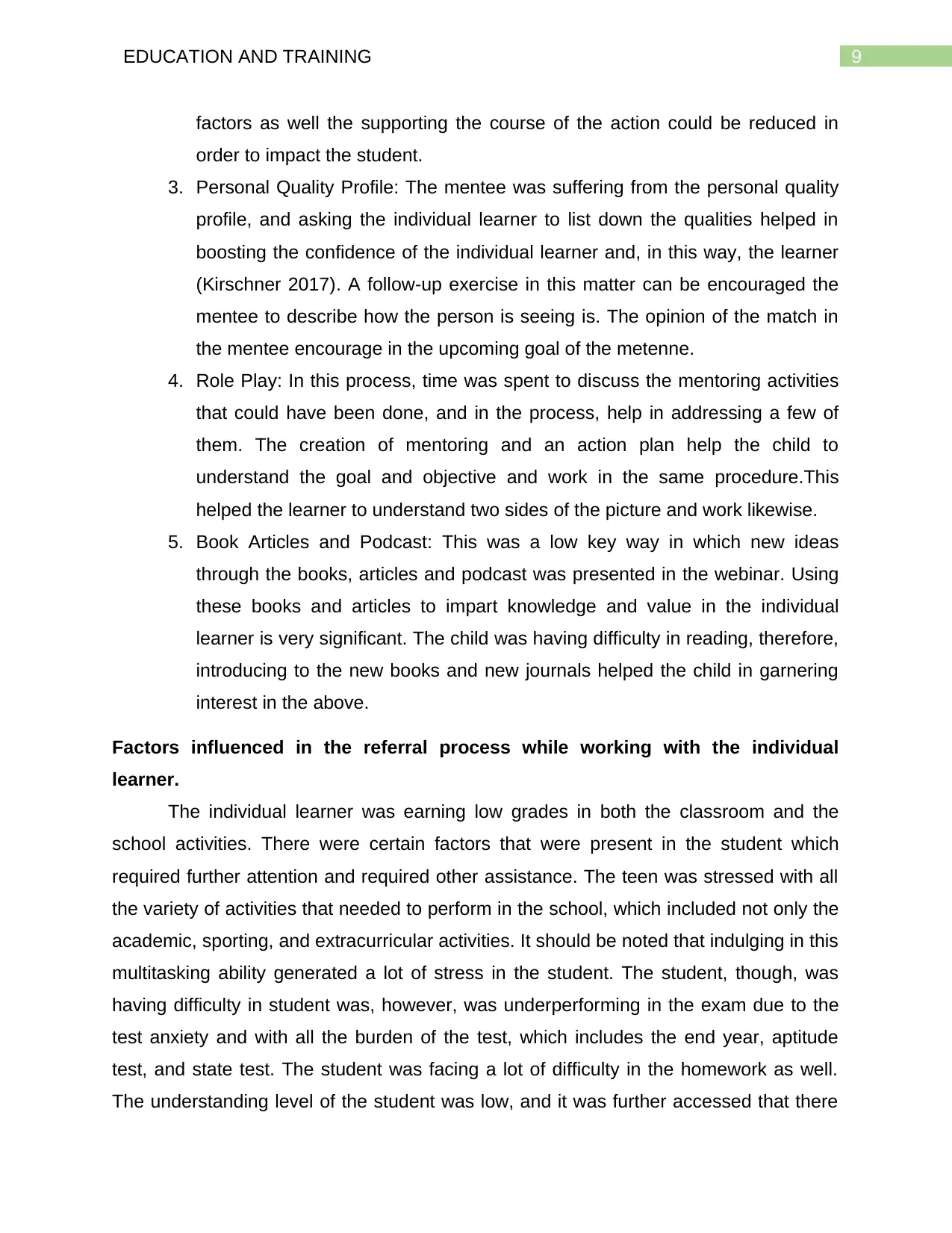
9EDUCATION AND TRAINING
factors as well the supporting the course of the action could be reduced in
order to impact the student.
3. Personal Quality Profile: The mentee was suffering from the personal quality
profile, and asking the individual learner to list down the qualities helped in
boosting the confidence of the individual learner and, in this way, the learner
(Kirschner 2017). A follow-up exercise in this matter can be encouraged the
mentee to describe how the person is seeing is. The opinion of the match in
the mentee encourage in the upcoming goal of the metenne.
4. Role Play: In this process, time was spent to discuss the mentoring activities
that could have been done, and in the process, help in addressing a few of
them. The creation of mentoring and an action plan help the child to
understand the goal and objective and work in the same procedure.This
helped the learner to understand two sides of the picture and work likewise.
5. Book Articles and Podcast: This was a low key way in which new ideas
through the books, articles and podcast was presented in the webinar. Using
these books and articles to impart knowledge and value in the individual
learner is very significant. The child was having difficulty in reading, therefore,
introducing to the new books and new journals helped the child in garnering
interest in the above.
Factors influenced in the referral process while working with the individual
learner.
The individual learner was earning low grades in both the classroom and the
school activities. There were certain factors that were present in the student which
required further attention and required other assistance. The teen was stressed with all
the variety of activities that needed to perform in the school, which included not only the
academic, sporting, and extracurricular activities. It should be noted that indulging in this
multitasking ability generated a lot of stress in the student. The student, though, was
having difficulty in student was, however, was underperforming in the exam due to the
test anxiety and with all the burden of the test, which includes the end year, aptitude
test, and state test. The student was facing a lot of difficulty in the homework as well.
The understanding level of the student was low, and it was further accessed that there
factors as well the supporting the course of the action could be reduced in
order to impact the student.
3. Personal Quality Profile: The mentee was suffering from the personal quality
profile, and asking the individual learner to list down the qualities helped in
boosting the confidence of the individual learner and, in this way, the learner
(Kirschner 2017). A follow-up exercise in this matter can be encouraged the
mentee to describe how the person is seeing is. The opinion of the match in
the mentee encourage in the upcoming goal of the metenne.
4. Role Play: In this process, time was spent to discuss the mentoring activities
that could have been done, and in the process, help in addressing a few of
them. The creation of mentoring and an action plan help the child to
understand the goal and objective and work in the same procedure.This
helped the learner to understand two sides of the picture and work likewise.
5. Book Articles and Podcast: This was a low key way in which new ideas
through the books, articles and podcast was presented in the webinar. Using
these books and articles to impart knowledge and value in the individual
learner is very significant. The child was having difficulty in reading, therefore,
introducing to the new books and new journals helped the child in garnering
interest in the above.
Factors influenced in the referral process while working with the individual
learner.
The individual learner was earning low grades in both the classroom and the
school activities. There were certain factors that were present in the student which
required further attention and required other assistance. The teen was stressed with all
the variety of activities that needed to perform in the school, which included not only the
academic, sporting, and extracurricular activities. It should be noted that indulging in this
multitasking ability generated a lot of stress in the student. The student, though, was
having difficulty in student was, however, was underperforming in the exam due to the
test anxiety and with all the burden of the test, which includes the end year, aptitude
test, and state test. The student was facing a lot of difficulty in the homework as well.
The understanding level of the student was low, and it was further accessed that there
Paraphrase This Document
Need a fresh take? Get an instant paraphrase of this document with our AI Paraphraser
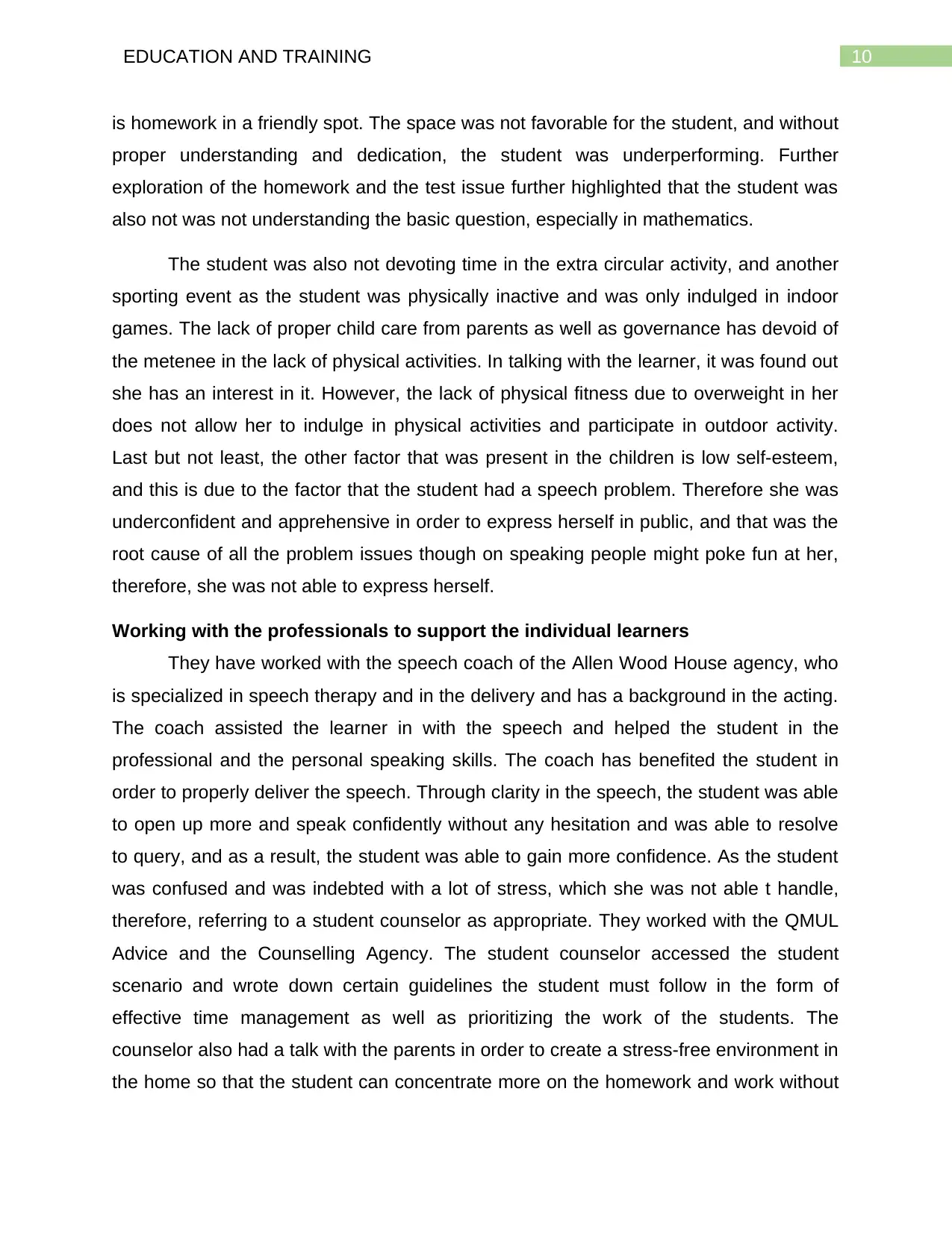
10EDUCATION AND TRAINING
is homework in a friendly spot. The space was not favorable for the student, and without
proper understanding and dedication, the student was underperforming. Further
exploration of the homework and the test issue further highlighted that the student was
also not was not understanding the basic question, especially in mathematics.
The student was also not devoting time in the extra circular activity, and another
sporting event as the student was physically inactive and was only indulged in indoor
games. The lack of proper child care from parents as well as governance has devoid of
the metenee in the lack of physical activities. In talking with the learner, it was found out
she has an interest in it. However, the lack of physical fitness due to overweight in her
does not allow her to indulge in physical activities and participate in outdoor activity.
Last but not least, the other factor that was present in the children is low self-esteem,
and this is due to the factor that the student had a speech problem. Therefore she was
underconfident and apprehensive in order to express herself in public, and that was the
root cause of all the problem issues though on speaking people might poke fun at her,
therefore, she was not able to express herself.
Working with the professionals to support the individual learners
They have worked with the speech coach of the Allen Wood House agency, who
is specialized in speech therapy and in the delivery and has a background in the acting.
The coach assisted the learner in with the speech and helped the student in the
professional and the personal speaking skills. The coach has benefited the student in
order to properly deliver the speech. Through clarity in the speech, the student was able
to open up more and speak confidently without any hesitation and was able to resolve
to query, and as a result, the student was able to gain more confidence. As the student
was confused and was indebted with a lot of stress, which she was not able t handle,
therefore, referring to a student counselor as appropriate. They worked with the QMUL
Advice and the Counselling Agency. The student counselor accessed the student
scenario and wrote down certain guidelines the student must follow in the form of
effective time management as well as prioritizing the work of the students. The
counselor also had a talk with the parents in order to create a stress-free environment in
the home so that the student can concentrate more on the homework and work without
is homework in a friendly spot. The space was not favorable for the student, and without
proper understanding and dedication, the student was underperforming. Further
exploration of the homework and the test issue further highlighted that the student was
also not was not understanding the basic question, especially in mathematics.
The student was also not devoting time in the extra circular activity, and another
sporting event as the student was physically inactive and was only indulged in indoor
games. The lack of proper child care from parents as well as governance has devoid of
the metenee in the lack of physical activities. In talking with the learner, it was found out
she has an interest in it. However, the lack of physical fitness due to overweight in her
does not allow her to indulge in physical activities and participate in outdoor activity.
Last but not least, the other factor that was present in the children is low self-esteem,
and this is due to the factor that the student had a speech problem. Therefore she was
underconfident and apprehensive in order to express herself in public, and that was the
root cause of all the problem issues though on speaking people might poke fun at her,
therefore, she was not able to express herself.
Working with the professionals to support the individual learners
They have worked with the speech coach of the Allen Wood House agency, who
is specialized in speech therapy and in the delivery and has a background in the acting.
The coach assisted the learner in with the speech and helped the student in the
professional and the personal speaking skills. The coach has benefited the student in
order to properly deliver the speech. Through clarity in the speech, the student was able
to open up more and speak confidently without any hesitation and was able to resolve
to query, and as a result, the student was able to gain more confidence. As the student
was confused and was indebted with a lot of stress, which she was not able t handle,
therefore, referring to a student counselor as appropriate. They worked with the QMUL
Advice and the Counselling Agency. The student counselor accessed the student
scenario and wrote down certain guidelines the student must follow in the form of
effective time management as well as prioritizing the work of the students. The
counselor also had a talk with the parents in order to create a stress-free environment in
the home so that the student can concentrate more on the homework and work without
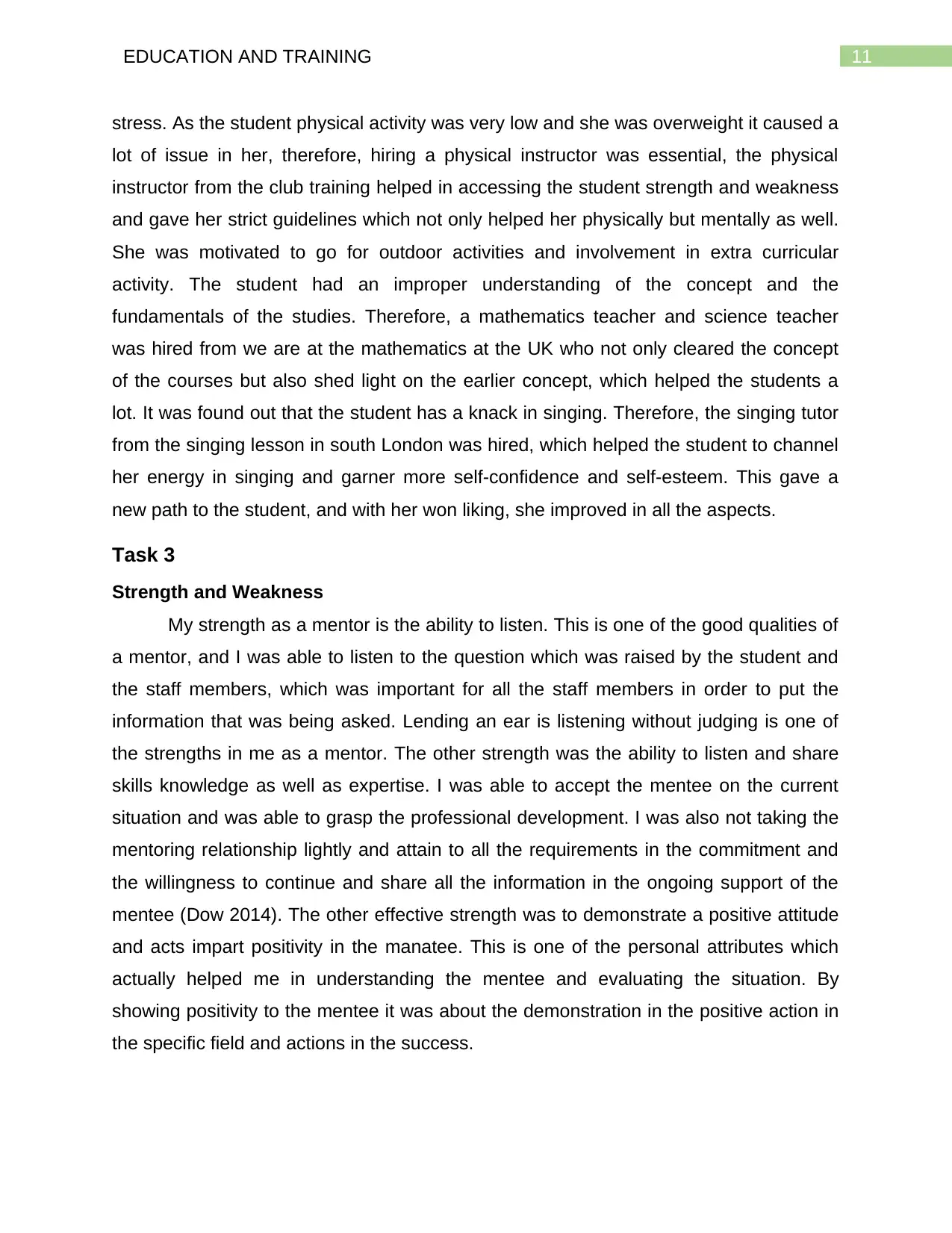
11EDUCATION AND TRAINING
stress. As the student physical activity was very low and she was overweight it caused a
lot of issue in her, therefore, hiring a physical instructor was essential, the physical
instructor from the club training helped in accessing the student strength and weakness
and gave her strict guidelines which not only helped her physically but mentally as well.
She was motivated to go for outdoor activities and involvement in extra curricular
activity. The student had an improper understanding of the concept and the
fundamentals of the studies. Therefore, a mathematics teacher and science teacher
was hired from we are at the mathematics at the UK who not only cleared the concept
of the courses but also shed light on the earlier concept, which helped the students a
lot. It was found out that the student has a knack in singing. Therefore, the singing tutor
from the singing lesson in south London was hired, which helped the student to channel
her energy in singing and garner more self-confidence and self-esteem. This gave a
new path to the student, and with her won liking, she improved in all the aspects.
Task 3
Strength and Weakness
My strength as a mentor is the ability to listen. This is one of the good qualities of
a mentor, and I was able to listen to the question which was raised by the student and
the staff members, which was important for all the staff members in order to put the
information that was being asked. Lending an ear is listening without judging is one of
the strengths in me as a mentor. The other strength was the ability to listen and share
skills knowledge as well as expertise. I was able to accept the mentee on the current
situation and was able to grasp the professional development. I was also not taking the
mentoring relationship lightly and attain to all the requirements in the commitment and
the willingness to continue and share all the information in the ongoing support of the
mentee (Dow 2014). The other effective strength was to demonstrate a positive attitude
and acts impart positivity in the manatee. This is one of the personal attributes which
actually helped me in understanding the mentee and evaluating the situation. By
showing positivity to the mentee it was about the demonstration in the positive action in
the specific field and actions in the success.
stress. As the student physical activity was very low and she was overweight it caused a
lot of issue in her, therefore, hiring a physical instructor was essential, the physical
instructor from the club training helped in accessing the student strength and weakness
and gave her strict guidelines which not only helped her physically but mentally as well.
She was motivated to go for outdoor activities and involvement in extra curricular
activity. The student had an improper understanding of the concept and the
fundamentals of the studies. Therefore, a mathematics teacher and science teacher
was hired from we are at the mathematics at the UK who not only cleared the concept
of the courses but also shed light on the earlier concept, which helped the students a
lot. It was found out that the student has a knack in singing. Therefore, the singing tutor
from the singing lesson in south London was hired, which helped the student to channel
her energy in singing and garner more self-confidence and self-esteem. This gave a
new path to the student, and with her won liking, she improved in all the aspects.
Task 3
Strength and Weakness
My strength as a mentor is the ability to listen. This is one of the good qualities of
a mentor, and I was able to listen to the question which was raised by the student and
the staff members, which was important for all the staff members in order to put the
information that was being asked. Lending an ear is listening without judging is one of
the strengths in me as a mentor. The other strength was the ability to listen and share
skills knowledge as well as expertise. I was able to accept the mentee on the current
situation and was able to grasp the professional development. I was also not taking the
mentoring relationship lightly and attain to all the requirements in the commitment and
the willingness to continue and share all the information in the ongoing support of the
mentee (Dow 2014). The other effective strength was to demonstrate a positive attitude
and acts impart positivity in the manatee. This is one of the personal attributes which
actually helped me in understanding the mentee and evaluating the situation. By
showing positivity to the mentee it was about the demonstration in the positive action in
the specific field and actions in the success.
⊘ This is a preview!⊘
Do you want full access?
Subscribe today to unlock all pages.

Trusted by 1+ million students worldwide
1 out of 17
Related Documents
Your All-in-One AI-Powered Toolkit for Academic Success.
+13062052269
info@desklib.com
Available 24*7 on WhatsApp / Email
![[object Object]](/_next/static/media/star-bottom.7253800d.svg)
Unlock your academic potential
Copyright © 2020–2025 A2Z Services. All Rights Reserved. Developed and managed by ZUCOL.



